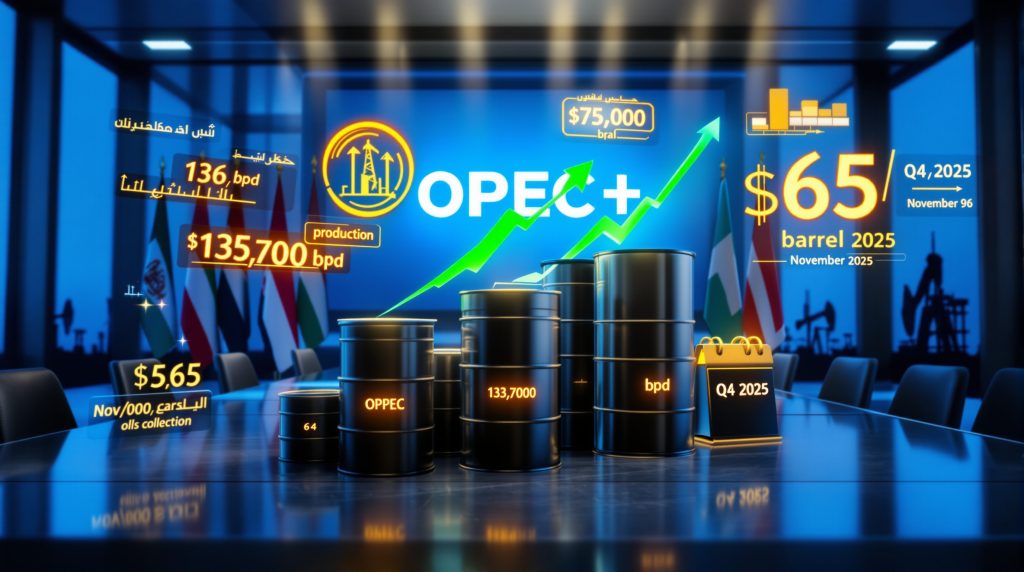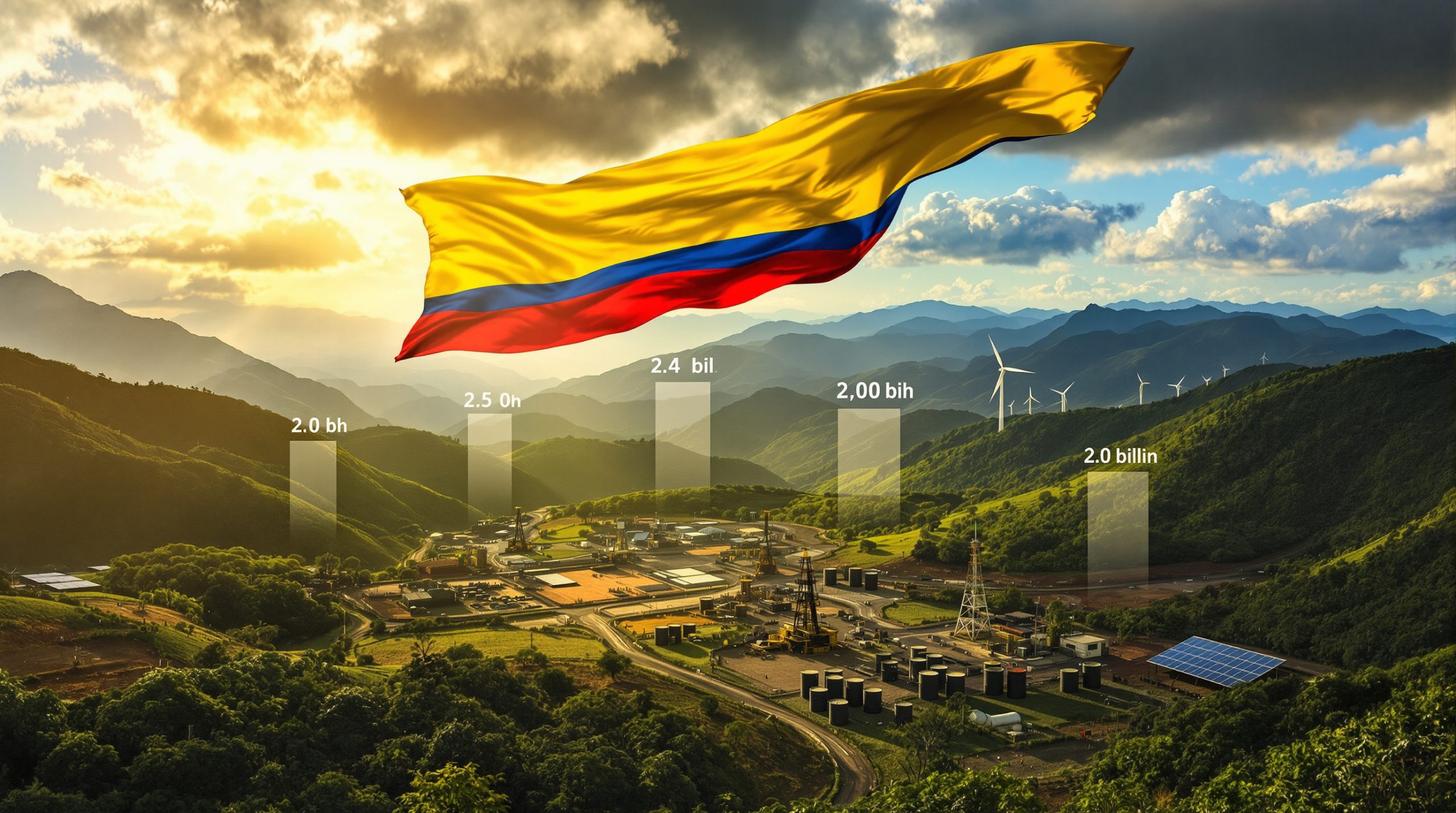Understanding OPEC+'s Current Production Strategy
The Organization of the Petroleum Exporting Countries and its allies (OPEC+) has established a sophisticated framework for managing global oil supply through measured production adjustments. This strategic approach centers on the systematic unwinding of voluntary production cuts that have shaped market dynamics since April 2023. As analysts develop their OPEC+ meeting prediction for November 2025, understanding this framework becomes crucial for market participants.
The Gradual Output Restoration Framework
OPEC+'s current production strategy operates through a 1.65 million barrels per day (bpd) additional voluntary adjustment mechanism that was initially announced in April 2023. This framework represents a coordinated effort among eight key member countries to gradually restore production levels while maintaining market stability.
The October 2025 virtual meeting demonstrated this approach in action, with participating countries implementing a 137,000 bpd monthly adjustment for November. This incremental increase pattern allows OPEC+ to respond to market conditions without creating dramatic supply shocks that could destabilize pricing. Furthermore, this measured approach reflects lessons learned from previous market cycles where aggressive supply adjustments created unwanted volatility.
Monthly Adjustment Distribution for November 2025:
| Country | Production Increase (bpd) | Required Production Level |
|---|---|---|
| Saudi Arabia | 41,000 | 10.061 million |
| Russia | 41,000 | 9.532 million |
| Iraq | 18,000 | 4.255 million |
| UAE | 12,000 | 3.399 million |
| Kuwait | 10,000 | 2.569 million |
| Kazakhstan | 7,000 | 1.563 million |
| Algeria | 4,000 | 967,000 |
| Oman | 4,000 | 808,000 |
The flexibility built into this system allows the organisation to pause, accelerate, or reverse adjustments based on evolving market conditions. According to official OPEC statements, the 1.65 million bpd adjustment may be returned in part or full, subject to continuous market assessment and maintaining a gradual implementation pace.
Key Players in the November Decision
Saudi Arabia and Russia maintain dominant positions within the adjustment framework, each contributing 41,000 bpd to the November increase. This represents approximately 60% of the total monthly adjustment, highlighting their leadership roles in OPEC+ decision-making processes.
The remaining six countries contribute smaller but strategically important increments:
• Iraq implements the third-largest increase at 18,000 bpd
• UAE contributes 12,000 bpd to the monthly adjustment
• Kuwait provides 10,000 bpd in additional production
• Kazakhstan adds 7,000 bpd to global supply
• Algeria and Oman each contribute 4,000 bpd
This distribution reflects both production capacity and organisational influence within OPEC+. The allocation system ensures that larger producers bear greater responsibility for supply adjustments while maintaining proportional representation among all participating countries. In addition, this approach has helped the organisation monitor compliance more effectively across diverse member states.
What Are Market Analysts Predicting for the November 2 Meeting?
Market consensus has coalesced around expectations for OPEC+'s November 2 meeting, with multiple independent analysis firms reaching identical quantitative forecasts. This convergence suggests high confidence in the organisation's established decision-making patterns and current market assessment. Consequently, the OPEC+ meeting prediction landscape shows remarkable uniformity among experts.
The 137,000 Barrel Per Day Consensus
Emily Ashford, Head of Energy Research at Standard Chartered Bank, projects that OPEC+ will continue gradual unwinding of cuts, adding a further 137,000 barrels per day month-on-month at the November 2 meeting. This prediction aligns precisely with the adjustment pattern established in October, indicating analyst confidence in policy continuity.
Independently, Konstantinos Chrysikos, Head of Customer Relationship Management at Kudotrade, reached the same quantitative conclusion, noting that traders anticipate a modest output increase for December of around 137,000 barrels per day. This analytical convergence suggests the market has formed strong consensus expectations around this specific increment.
Standard Chartered Bank Price Projections:
• Q4 2025: $65 per barrel (Brent crude average)
• Full year 2025: $68.50 per barrel (Brent crude average)
• Current market levels: WTI at $60.14, Brent at $64.59
The price forecasts provide context for understanding OPEC+'s production strategy. With current Brent pricing slightly below the projected Q4 average, the organisation appears to be calibrating supply increases to support price stability within their target range. However, these projections must be considered alongside broader geopolitical factors that could influence the oil price forecast throughout 2025.
Market Fundamentals Supporting Gradual Increases
Several technical indicators support continued incremental production increases. Forward curve dynamics have shifted significantly, moving from strong contango in early 2026 to steep backwardation in front months. This structural change indicates tightening physical market conditions that can accommodate additional supply without overwhelming demand.
"The week-on-week change in the Brent forward curve structure and Russia-based market supply concerns support OPEC+ continuing its small monthly unwinding of April 2023 voluntary output cuts."
Low oil inventory levels provide additional justification for supply increases. According to OPEC's official October statement, healthy market fundamentals are reflected in reduced inventory positions, suggesting physical markets can absorb additional barrels without creating oversupply conditions.
Key Supporting Market Indicators:
• Forward curve transition from contango to backwardation
• Below-average global oil inventory levels
• Steady global economic outlook assessments
• Improved market sentiment week-over-week
Furthermore, these fundamentals align with observations about US drilling decline, which may create additional space for OPEC+ production increases without destabilising global supply balances.
How Are Geopolitical Factors Shaping OPEC+ Decisions?
Geopolitical developments significantly influence OPEC+ production decisions, particularly regarding member countries facing external pressure or sanctions. Recent developments involving Russia and broader Middle East tensions create complex considerations for the organisation's strategy.
Impact of US Sanctions on Russian Energy Sector
The U.S. Treasury Department announced comprehensive sanctions targeting Russia's two largest oil companies on October 22, 2025. Treasury Secretary Scott Bessent emphasised that these actions increase pressure on Russia's energy sector and degrade the Kremlin's ability to raise revenue for military operations.
This sanctions escalation occurs just nine days before OPEC+'s November 2 meeting, creating potential complications for Russia's participation in production decisions. However, Russia maintains significant influence within OPEC+, contributing 41,000 bpd to the November adjustment alongside Saudi Arabia.
Russian President Vladimir Putin responded through official government channels, stating that sanctions will not significantly affect economic well-being. Putin emphasised that Russia's energy sector remains stable and confident, with substantial contributions to global energy balance.
Sanctions Impact Assessment:
• Direct targeting of Russia's largest oil producers
• Timing creates pressure ahead of OPEC+ meeting
• Russia maintains production leadership role within OPEC+
• Official Russian response emphasises sector stability
These developments coincide with broader concerns about the US economy outlook, which could influence global energy demand patterns and consequently affect OPEC+ production decisions.
Middle East Tensions and Supply Security
Regional stability concerns continue influencing OPEC+ strategic calculations. Member countries must balance production restoration with maintaining spare capacity for potential supply disruptions. This consideration becomes particularly relevant when evaluating the pace of voluntary cut unwinding.
The organisation's emphasis on flexibility reflects these geopolitical uncertainties. Official statements consistently highlight the ability to pause or reverse production adjustments, including the previously implemented 2.2 million bpd voluntary adjustments from November 2023.
Strategic reserve maintenance allows OPEC+ to respond quickly to supply disruptions while pursuing market share recovery objectives. This dual approach supports both revenue generation and supply security considerations. In addition, policy makers closely monitor regional developments that could affect oil price movements and adjust production strategies accordingly.
What Price Targets Are Driving OPEC+ Strategy?
OPEC+ production decisions reflect careful calibration around price targets that balance revenue optimisation with market share considerations. Current projections suggest the organisation is managing supply to maintain prices within specific ranges while avoiding demand destruction.
Fourth Quarter 2025 Price Projections
Standard Chartered Bank forecasts provide insight into the price environment informing OPEC+ decisions. The projection of $65 per barrel average for Q4 2025 and $68.50 for the full year establishes the approximate range within which production adjustments are calibrated.
Current market pricing shows WTI crude at $60.14 and Brent crude at $64.59, placing levels slightly below the Q4 projection. This differential suggests modest upside potential exists, supporting the case for measured production increases rather than aggressive supply additions.
Price Target Framework:
• Q4 2025 target: $65/barrel (Brent)
• Full-year 2025 target: $68.50/barrel (Brent)
• Current gap: Approximately $0.41 below Q4 target
• Policy implication: Gradual increases appropriate
Balancing Act Between Revenue and Market Share
OPEC+ faces competing pressures between maximising short-term revenue through higher prices and maintaining long-term market share against growing U.S. shale production. The 137,000 bpd monthly adjustment represents a compromise approach that gradually restores production without flooding markets.
This strategy acknowledges that overly aggressive production increases could trigger price declines that ultimately reduce total revenue despite higher volumes. Conversely, maintaining cuts indefinitely risks permanent market share loss to non-OPEC+ producers.
The organisation's flexibility mechanisms allow rapid strategy adjustments if competitive dynamics change. Monthly monitoring enables quick responses to shifts in U.S. shale growth rates or demand patterns that could alter the optimal production trajectory. For instance, developments in Alaska drilling policy could affect North American supply dynamics and influence OPEC+ decisions.
Why Is OPEC+ Maintaining Flexibility in Their Approach?
Flexibility represents a core principle of OPEC+'s current production strategy, enabling rapid response to changing market conditions while maintaining organisational credibility. This approach reflects lessons learned from previous market cycles where rigid policies proved counterproductive.
The Pause and Reverse Mechanism
OPEC+ has built explicit pause and reverse capabilities into its production framework. The organisation retains the ability to halt monthly increases or reverse previous adjustments, including the 2.2 million bpd voluntary cuts implemented in November 2023.
This flexibility extends beyond the current 1.65 million bpd framework to encompass broader production policy tools. The mechanism allows OPEC+ to respond quickly to demand deterioration, supply disruptions from non-members, or significant inventory accumulation.
Flexibility Tools Available:
• Monthly increment pause capability
• Full reversal of recent adjustments
• Access to November 2023 cut volumes
• Virtual meeting protocols for rapid decisions
Compensation and Conformity Monitoring
The Joint Ministerial Monitoring Committee (JMMC) provides ongoing oversight of member compliance with declared production targets. This monitoring system ensures that production increases occur within agreed parameters while addressing historical overproduction issues.
Member countries must compensate for overproduced volumes since January 2024 before implementing new adjustments. This requirement creates accountability within the system while providing fiscal space for countries to address compliance shortfalls.
Monthly meetings review market conditions, conformity levels, and compensation progress, establishing a formal governance cycle that enables rapid policy adjustments based on real-time data. Furthermore, this systematic approach enhances the credibility of each OPEC+ meeting prediction by providing transparent monitoring mechanisms.
What Could Trigger a Different Outcome at the Meeting?
While market consensus expects continuation of the 137,000 bpd monthly adjustment pattern, several factors could prompt OPEC+ to alter course at the November 2 meeting. Understanding these potential triggers provides insight into the organisation's decision-making framework.
Scenarios That Might Delay Production Increases
Sudden deterioration in global economic indicators could prompt OPEC+ to pause production increases. Signs of recession in major consuming economies would likely trigger reassessment of demand projections and adjustment timelines.
Significant inventory accumulation represents another potential pause trigger. If weekly inventory reports show substantial builds in key storage hubs, the organisation might delay increases to allow markets time to rebalance.
Potential Pause Triggers:
• Economic recession signals in major economies
• Weekly inventory builds exceeding expectations
• Demand forecasts showing significant deterioration
• Non-OPEC+ supply disruptions creating oversupply risk
Major supply disruptions from non-OPEC+ producers could also prompt delays. If U.S. shale production growth accelerates beyond expectations or other producers announce significant capacity additions, OPEC+ might reassess the appropriate pace of its own increases.
Factors That Could Accelerate Output Growth
Stronger-than-expected demand recovery could prompt larger production adjustments. If economic data shows accelerating growth in major consuming regions, OPEC+ might increase monthly adjustments to capture additional market share.
Competitive pressure from expanding U.S. shale production creates incentives for accelerated OPEC+ restoration. Prolonged production restraint could result in permanent market share loss if alternative suppliers fill the gap.
Member country fiscal pressures provide additional acceleration incentives. Countries requiring higher revenue for budget balancing might advocate for faster production restoration to maximise earnings. However, such decisions must be balanced against market capacity to absorb additional supply without triggering price volatility.
How Will the November Decision Impact Global Oil Markets?
OPEC+'s November 2 decision will generate immediate market reactions while establishing expectations for future policy direction. Understanding these impact mechanisms helps anticipate both short-term volatility and longer-term trend implications.
Short-Term Market Response Expectations
Trader positioning ahead of the announcement suggests markets have largely priced in the expected 137,000 bpd increase. Confirmation of analyst forecasts would likely generate minimal volatility, while deviations could trigger significant price movements.
A larger-than-expected increase would likely pressure prices downward, while a pause or reduction would support upward price movement. The magnitude of response depends on the size of deviation from consensus expectations.
Expected Market Reactions:
• Consensus confirmation: Minimal volatility
• Larger increase: Downward price pressure
• Production pause: Upward price support
• Complete reversal: Significant price rally
Forward curve dynamics will adjust based on the decision outcome. Continued gradual increases should support the current backwardation structure in front months, while policy changes could alter curve relationships across the entire pricing spectrum.
Long-Term Strategic Implications
The November decision establishes precedent for OPEC+'s approach to unwinding remaining voluntary cuts. A predictable monthly adjustment pattern builds market confidence in the organisation's systematic approach while maintaining flexibility for future changes.
Timeline implications for full production restoration depend heavily on the adjustment pace confirmed in November. At 137,000 bpd monthly increments, complete unwinding of the 1.65 million bpd framework would require approximately 12 months, assuming no pauses or reversals.
Global energy transition considerations may influence long-term production strategy. As renewable energy adoption accelerates, OPEC+ must balance current market share protection with recognition of potentially declining long-term oil demand. Consequently, each OPEC+ meeting prediction becomes increasingly important for understanding this transition period.
What Should Energy Investors Watch For?
Energy sector investors should monitor specific elements of OPEC+'s November 2 announcement to understand immediate market implications and longer-term strategic direction. Key announcement details will provide crucial insight for portfolio positioning and risk management.
Key Announcement Details to Monitor
Production allocation changes by individual country reveal internal OPEC+ dynamics and potential compliance issues. Variations from expected distributions might signal disagreements or capacity constraints among member countries.
Implementation timeline specifics determine how quickly market impacts will materialise. Standard monthly implementation suggests policy continuity, while alternative timing could indicate organisational concerns or market response considerations.
Critical Announcement Elements:
• Specific country-by-country allocation changes
• Implementation timeline and effective dates
• Language regarding future meeting frequency
• Flexibility mechanism activation criteria
• Compliance and compensation requirements
Communication language regarding future decision criteria provides insight into OPEC+'s market assessment framework. References to inventory levels, economic indicators, or geopolitical factors highlight the organisation's priority considerations. For instance, Reuters reports suggest that OPEC+ decision-makers are closely monitoring these multiple variables when formulating policy.
Market Indicators Following the Decision
Immediate price reactions in Brent and WTI crude futures will establish market interpretation of the announcement. Price direction and magnitude indicate whether markets view the decision as hawkish, dovish, or neutral.
Currency impacts on oil-exporting nation economies provide secondary indicators of decision significance. Strengthening currencies in OPEC+ countries suggest market confidence in revenue prospects, while weakening indicates concern about competitive positioning.
Downstream effects on refined product markets and energy sector equities extend the decision's impact beyond crude oil pricing. Refinery margins, gasoline futures, and energy stock performance reflect broader market assessment of supply-demand balance implications.
Energy sector investment flows following the announcement reveal institutional investor positioning. Increased capital allocation to oil and gas companies suggests confidence in pricing stability, while outflows indicate concerns about oversupply or demand weakness.
Post-Decision Monitoring Framework:
• Crude oil futures price responses (Brent, WTI)
• Oil-exporting country currency movements
• Refined product pricing adjustments
• Energy sector equity performance
• Investment flow patterns in oil and gas assets
Disclaimer: This analysis is based on publicly available information and expert assessments as of October 31, 2025. Oil market conditions and OPEC+ policies can change rapidly based on geopolitical developments, economic conditions, and unforeseen circumstances. Investors should conduct their own due diligence and consider multiple perspectives when making investment decisions related to energy markets.
Looking to Capitalise on Energy Market Movements?
Discovery Alert's proprietary Discovery IQ model delivers real-time alerts on significant ASX mineral discoveries, including energy sector opportunities that could benefit from shifting oil market dynamics and commodity price movements. Explore how major mineral discoveries have generated substantial returns by visiting Discovery Alert's dedicated discoveries page, and begin your 30-day free trial today to position yourself ahead of the market.




